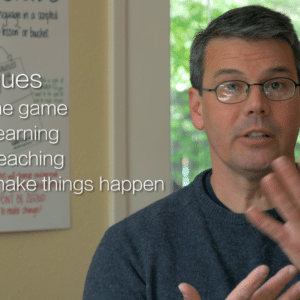Once we agree to share accelerators that work through tq “Technique!”, it leads us to tq “Obviously!”: the mother of all other techniques. Every technique in the WAYK system exists to serve this primary principle.
Success drives learning – failure undermines it.
Many people in our culture are very familiar with negative feelings around learning – with failure, frustration, embarrassment. With worrying over whether or not they’ll make a mistake, or say something wrong in front of peers. They’ve taken on labels, “smart”, “stupid”, “average”, without really understanding why. They’re stuck.
This is where we often start when it comes to learning something new; all these old feelings are immediately present, and must be dealt with.
To learn or teach something, your job then is to build up an immense amount of experience successfully using the target skill, and absolutely minimize the amount of failure or frustration.
Ideally, the learning experience feels like mind-reading, or like downloading a mastery of kung fu in The Matrix.
Learning something new already brings with it a large amount of confusion and uncertainty. By eliminating as much confusion and uncertainty as possible, the student can focus on one thing at a time – the chunk of skill that is the very next step.
When all the players constantly attend to mastering this very-next-step, they enter what author Mihaly Csikszentmihalyi calls the flow state – experiencing energized focus, full involvement, and success in the ongoing activity.
This is an ideal state for learning. Through technique “obviously!” we are able to design experiences (games) that maintain this state for players.
WAYK is a design system for creating accelerated learning games that put players in a flow state.
Introducing the technique
Short: “Everyone do your best 10 year old girl impression with me – ‘Obviously!’. [do multiple times to get folks into it]. Technique ‘Obviously!’ is one of the first rules of this game; it means everything in this game should be obvious. All the questions I’ll ask are ‘obvious’ questions. This is obviously a red pen. That is obviously a rock.”
Applying the technique in language acquisition
Make sure everything is absolutely clear. Remove all opportunity for guessing. Remove all tricks or testing. Here are a few specific ways to do it; however every WAYK technique is an expression of tq “Obviously!” in some form.
- Create TQ Total Physical Response by removing all pretend and imagination to start the conversation; endeavor to use the actual objects and environment that the language is referring to.
- Make sure every conversational prop is “obviously!” what you intend it to be; red pens are clearly red pens, with no other colors or decoration, and they write red. Rocks are iconic “rocks”, that players intuitively perceive as a “rock”, rather than a pebble, boulder, shard, etc.
- The playing surface (table) and environment (room, walls, ceiling) have minimal visual noise and activity to distract or confuse. The table is free of anything that is not in the conversation (players’ food, drinks, personal items).
- TQ Lawyer-up by only asking players what they already know, or be there to tq Pull them through it. “Is that a red pen? Yes, that’s a red pen!”
But what about…?
Initially, some students and teachers may balk at the lack of intellectual challenge in the form of trickery, tests, or technical explanations. If it’s too easy, too “obvious”, will it be fun? If I’m not tested, how do I know what I am good at? If I don’t have a technical understanding, am I actually learning?
We leave it to others to do the science on why “obviously!” works. In thousands of hours of game play, over almost a decade, we’ve found it works, time and again. And the more “obviously!” they apply to the game, the more players experience acceleration.
When it comes to technical explanations, we don’t want to just know “about” a skill – we want become competent at the skill. We seem to learn best by doing. Many classroom-educated students know a lot “about” the language they studied; few learned to actually speak it fluently in the classroom.
Therefore, puzzling through the skill at hand is not the goal – fluent competency as soon as possible, via “obviously!”, is the goal.
However, there is still room for puzzle solving, intellectual challenge, and testing – there must be, because puzzle solving is fun and drives learning too. And testing tells us where to go next, what we still have to master.
• TQ Riddle-Me-This gives our urge to solve puzzles its most useful focus – there’s still a mystery to solve, but it doesn’t slow us down.
• TQ Fluency Hunting challenges our ability to wield techniques to their utmost.
• TQ No-grief Debriefs provide a chance for sifting through our experiences and looking for ways to improve play and innovate new techniques.
• TQ Travels with Charlie provides a never-ending diagnosis of where we’re at, and where we still have to go.






